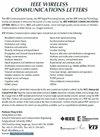移动接入点辅助集成可见光通信和传感网络
IF 5.5
3区 计算机科学
Q1 COMPUTER SCIENCE, INFORMATION SYSTEMS
引用次数: 0
摘要
可见光通信(VLC)的出现为有限频谱的无线网络提供了一种有前途的低成本、无辐射和节能的解决方案。然而,视距(LOS)阻塞、用户移动性支持、随机设备方向以及VLC接入点(ap)和接收器的有限视野等设计问题推迟了VLC的采用。这封信探讨了在基于可见光的联合通信和传感系统中使用可移动AP (MAP)技术来解决这些问题。首先,提出了一种地图辅助可见光通信与传感集成网络的系统模型。然后,通过对map的位置和用户关联进行联合优化,构造了一个非凸优化问题,以最大化聚合速率和感知互信息(MI)。利用凸函数的差分和最大-最小技术,提出了一种求局部最优解的低复杂度算法。仿真结果表明,与固定AP系统相比,所提出的地图辅助IVLCS系统对链路阻塞具有更强的鲁棒性,提供了移动性支持,并且可以显着提高总求和率和MI。本文章由计算机程序翻译,如有差异,请以英文原文为准。
Movable Access Point-Aided Integrated Visible Light Communication and Sensing Networks
The emergence of visible light communication (VLC) provides a promising low-cost, radiation-free, and energy-efficient solution to the limited spectrum of wireless networks. However, the design issues of line-of-sight (LOS) blockage, user mobility support, random device orientation, and the limited field-of-view of VLC access points (APs) and receivers have delayed its adoption. This letter explores the use of movable AP (MAP) technology to address these issues in a visible light based joint communication and sensing system. First, a system model for a MAP-aided integrated visible light communication and sensing (IVLCS) network is proposed. Then, a non-convex optimization problem is formulated to maximize the aggregate sum rate and sensing mutual information (MI) by jointly optimizing MAPs’ position and user association. A low-complexity algorithm that obtains a locally optimal solution is proposed by leveraging the difference of convex functions and the majorization-minimization technique. Simulation results reveal that the proposed MAP-aided IVLCS system is more robust against link blockages, provides mobility support and can significantly enhance aggregate sum rate and MI compared to a fixed AP system.
求助全文
通过发布文献求助,成功后即可免费获取论文全文。
去求助
来源期刊

IEEE Wireless Communications Letters
Engineering-Electrical and Electronic Engineering
CiteScore
12.30
自引率
6.30%
发文量
481
期刊介绍:
IEEE Wireless Communications Letters publishes short papers in a rapid publication cycle on advances in the state-of-the-art of wireless communications. Both theoretical contributions (including new techniques, concepts, and analyses) and practical contributions (including system experiments and prototypes, and new applications) are encouraged. This journal focuses on the physical layer and the link layer of wireless communication systems.
 求助内容:
求助内容: 应助结果提醒方式:
应助结果提醒方式:


